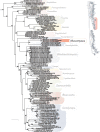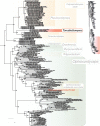Masters of the manipulator: two new hypocrealean genera, Niveomyces (Cordycipitaceae) and Torrubiellomyces (Ophiocordycipitaceae), parasitic on the zombie ant fungus Ophiocordyceps camponoti-floridani
- PMID: 38234384
- PMCID: PMC10792228
- DOI: 10.3767/persoonia.2022.49.05
Masters of the manipulator: two new hypocrealean genera, Niveomyces (Cordycipitaceae) and Torrubiellomyces (Ophiocordycipitaceae), parasitic on the zombie ant fungus Ophiocordyceps camponoti-floridani
Abstract
During surveys in central Florida of the zombie-ant fungus Ophiocordyceps camponoti-floridani, which manipulates the behavior of the carpenter ant Camponotus floridanus, two distinct fungal morphotypes were discovered associated with and purportedly parasitic on O. camponoti-floridani. Based on a combination of unique morphology, ecology and phylogenetic placement, we discovered that these morphotypes comprise two novel lineages of fungi. Here, we propose two new genera, Niveomyces and Torrubiellomyces, each including a single species within the families Cordycipitaceae and Ophiocordycipitaceae, respectively. We generated de novo draft genomes for both new species and performed morphological and multi-loci phylogenetic analyses. The macromorphology and incidence of both new species, Niveomyces coronatus and Torrubiellomyces zombiae, suggest that these fungi are mycoparasites since their growth is observed exclusively on O. camponoti-floridani mycelium, stalks and ascomata, causing evident degradation of their fungal hosts. This work provides a starting point for more studies into fungal interactions between mycopathogens and entomopathogens, which have the potential to contribute towards efforts to battle the global rise of plant and animal mycoses. Citation: Araújo JPM, Lebert BM, Vermeulen S, et al. 2022. Masters of the manipulator: two new hypocrealean general, Niveomyces (Cordycipitaceae) and Torrubiellomyces (Ophiocordycipitaceae), parasitic on the zombie ant fungus Ophiocordyceps camponoti-floridani. Persoonia 49: 171-194. https://doi.org/10.3767/persoonia.2022.49.05.
Keywords: Hypocreales; behaviour manipulation; entomopathogenic fungi; genomics; mycoparasites; new taxa; taxonomy.
© 2022 Naturalis Biodiversity Center & Westerdijk Fungal Biodiversity Institute.
Conflict of interest statement
The authors declare that there is no conflict of interest.
Figures






Similar articles
-
Zombie-ant fungi across continents: 15 new species and new combinations within Ophiocordyceps. I. Myrmecophilous hirsutelloid species.Stud Mycol. 2018 Jun;90:119-160. doi: 10.1016/j.simyco.2017.12.002. Epub 2018 Jan 2. Stud Mycol. 2018. PMID: 29910522 Free PMC article.
-
New mycoparasitic species in the genera Niveomyces and Pseudoniveomycesgen. nov. (Hypocreales: Cordycipitaceae), with sporothrix-like asexual morphs, from Thailand.Fungal Syst Evol. 2023 Nov;12:91-110. doi: 10.3114/fuse.2023.12.07. Epub 2023 Aug 28. Fungal Syst Evol. 2023. PMID: 38533477 Free PMC article.
-
Consequences of "zombie-making" and generalist fungal pathogens on carpenter ant microbiota.Curr Res Insect Sci. 2024 Nov 30;7:100102. doi: 10.1016/j.cris.2024.100102. eCollection 2025. Curr Res Insect Sci. 2024. PMID: 39720458 Free PMC article.
-
Hijacking time: How Ophiocordyceps fungi could be using ant host clocks to manipulate behavior.Parasite Immunol. 2022 Mar;44(3):e12909. doi: 10.1111/pim.12909. Parasite Immunol. 2022. PMID: 35103986 Free PMC article. Review.
-
Mechanisms Underlying Ophiocordyceps Infection and Behavioral Manipulation of Ants: Unique or Ubiquitous?Annu Rev Microbiol. 2024 Nov;78(1):575-593. doi: 10.1146/annurev-micro-041522-092522. Epub 2024 Nov 7. Annu Rev Microbiol. 2024. PMID: 39270680 Review.
Cited by
-
New species and new combinations in the genus Paraisaria (Hypocreales, Ophiocordycipitaceae) from the U.S.A., supported by polyphasic analysis.MycoKeys. 2023 Nov 13;100:69-94. doi: 10.3897/mycokeys.100.110959. eCollection 2023. MycoKeys. 2023. PMID: 38025585 Free PMC article.
-
Molecular phylogeny and morphology reveal four novel species in Cordycipitaceae in China.MycoKeys. 2025 Apr 9;116:91-124. doi: 10.3897/mycokeys.116.147006. eCollection 2025. MycoKeys. 2025. PMID: 40248652 Free PMC article.
-
New treasures in Cordycipitaceae: Fungicolous fungi associated with Pseudocercospora fijiensis and P. musae in Brazil, including Matutinistella gen. nov.Fungal Syst Evol. 2025 Jun;15:133-152. doi: 10.3114/fuse.2025.15.06. Epub 2024 Oct 18. Fungal Syst Evol. 2025. PMID: 40170761 Free PMC article.
-
2023 BMC Ecology and Evolution image competition: the winning images.BMC Ecol Evol. 2023 Aug 18;23(1):32. doi: 10.1186/s12862-023-02141-x. BMC Ecol Evol. 2023. PMID: 37592219 Free PMC article.
-
Multi-locus molecular phylogenetic analysis reveals two new species of Amphichorda (Bionectriaceae, Hypocreales).MycoKeys. 2024 Jul 3;106:287-301. doi: 10.3897/mycokeys.106.117205. eCollection 2024. MycoKeys. 2024. PMID: 38993356 Free PMC article.
References
-
- Andersen B, Nielsen KF, Thrane U, et al. 2003. Molecular and phenotypic descriptions of Stachybotrys chlorohalonata sp. nov. and two chemotypes of Stachybotrys chartarum found in water-damaged buildings. Mycology 95: 1227–1238. - PubMed
-
- Andersen SB, Gerritsma S, Yusah KM, et al. 2009. The life of a dead ant: the expression of an adaptive extended phenotype. American Naturalist 174: 424–433. - PubMed
-
- Andrews S. 2010. FastQC: A quality control tool for high throughput sequence data.
-
- Araújo JPM, Evans HC, Fernandes IO, et al. 2020. Zombie-ant fungi cross continents: II. Myrmecophilous hymenostilboid species and a novel zombie lineage. Mycologia 112: 1138–1170. - PubMed
LinkOut - more resources
Full Text Sources
